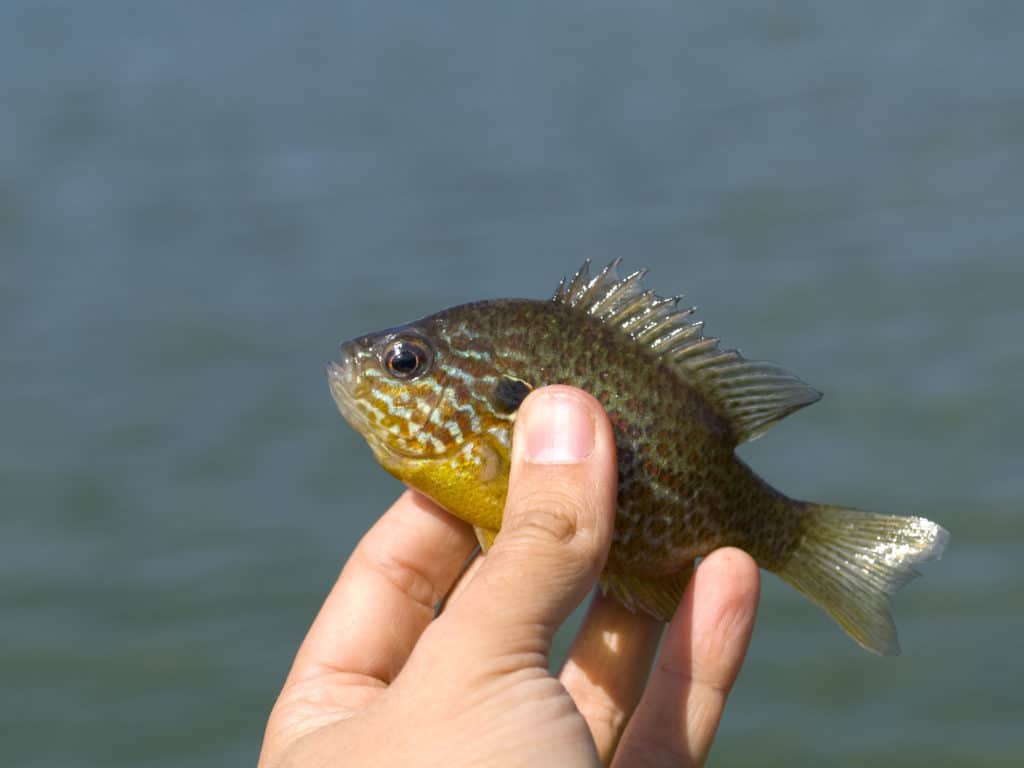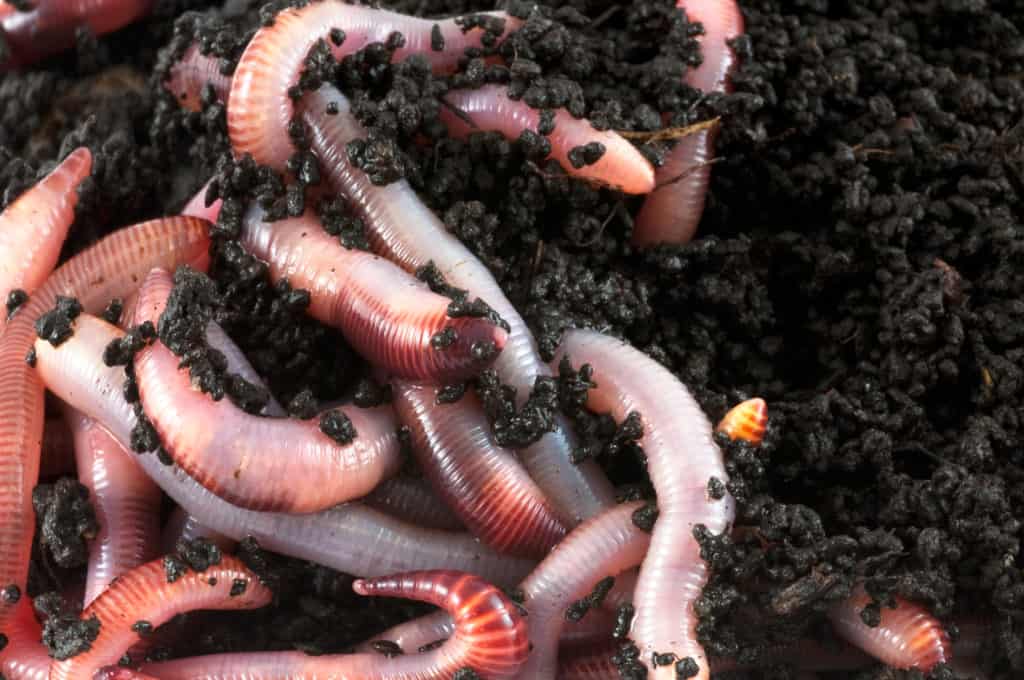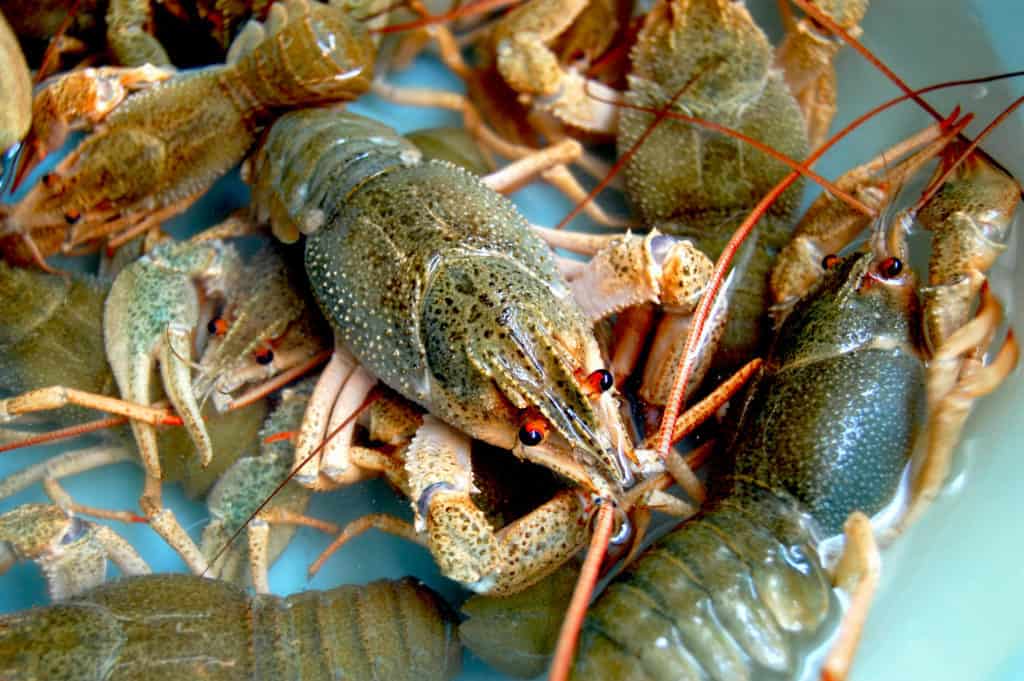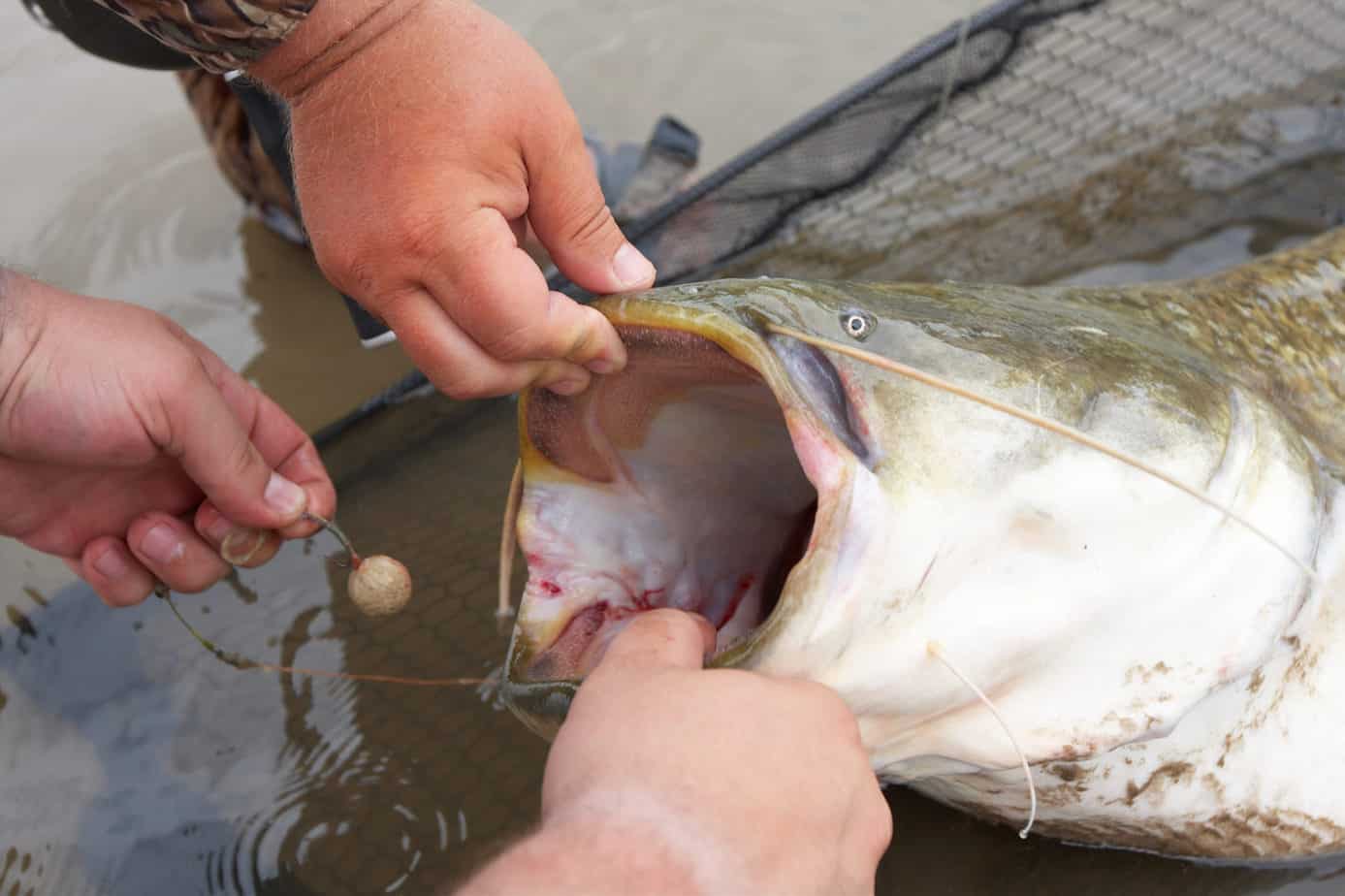Jug fishing or jug lining is using a buoyant jug, bottle, or homemade floating rig, to suspend the bait at a set depth while going after catfish. It is a very labor efficient method for catching channel cats, blue cats, and even flatheads.
One of the greatest things about jug fishing is how simple and autonomous it is. It increases the effectiveness of a single fisherman several times over.
Depending on state regulations, jugfishers may only use a certain number of juglines, but they can be used while also fishing with a rod and reel in some cases.
Being able to have multiple baited hooks in the water at once, the angler’s chances for getting a successful strike are multiplied.
The catch with jug fishing is that you have to follow the state guidelines and restrictions, or you could face severe penalties.
Missouri, for example, you can have up to 33 hooks out at any one time per licensed fisher, so if you have a rod and reel in your hand with a single hook on it, you can only have 32 juglines out.
In Texas, on the other hand, you can have up to 100 hooks per person. In states like Minnesota, California, Arizona, and Kansas, among some others, jig fishing is not legal at all on any state-regulated body of water.
Cut and Whole Fish

One of the best types of bait for catching catfish is fish. Whether you choose to use whole or cut up fish is entirely up to you based on your personal preferences and what type of catfish you are trying to catch.
My favorite baits include cut or whole shad, sunfish, carp, perch, and just about any other fresh or dead legal baitfish.
Make sure you know what types of catfish you are likely to encounter throughout your day on the water.
Shad, carp, and perch are all well-liked across the board. Blue catfish like fresh whole or cut bait and particularly enjoy oilier fish.
For channel catfish, smaller fish can be caught with dip or punch bait, but the bigger fish like fresh dead fish, either whole or cut up.
For a bullhead catfish, they like live minnows and small bluegills.
If you’re looking to catch flathead catfish, your best bet is going with a bait that is lively and hearty. They love live bait such as perch, brim, goldfish, and black salty’s.
After deciding what type of fish you’ll be using as bait, you need to decide how you’ll be prepping your bait for the trip.
Leaving smaller fish such as goldfish and minnows whole has the perk of the bait looking like small fish swimming in the water but that doesn’t always attract the catfish you are seeking.
Cutting your bait fish into chunks is helpful because catfish rely heavily on their sense of smell and a cut piece of fish smells stronger than it would if it were left whole.
Worms

When you hear the word “fishing”, one of the first things that come to mind is worms. If there’s one thing that’s certain it is that most fish can be successfully caught with worms.
The easiest way to acquire worms for your next fishing trip is to head to a local bait shop and purchase a container of live worms.
For just a few dollars, you can purchase containers of live worms that are ready for you to take out onto the water.
Catfish are no exception to this rule, of course, and one of the best baits you can use for jug fishing is worms.
Worms like nightcrawlers and earthworms are fantastic options for your next fishing trip. One of the benefits of using worms is that they can survive for a few hours both in the water and out of the water.
This allows them to wiggle on the hook which can help attract the fish for a longer amount of time. In addition to their longevity, worms are quite cost-effective.
Not only is a container of worms affordable to begin with, but you can also pinch longer worms into smaller pieces so you can get even more for your money.
There are a variety of worms that are available for you to choose from. The best types of fishing worms are leeches, red wigglers, nightcrawlers, mealworms, bloodworms, waxworms, and butterworms.
So head to your local bait shop or go outside and dig around in the dirt so you can try your hand at jug fishing with live worms.
Chicken Liver
Another one of the baits catfish love is chicken liver. Most grocery stores have organ meats available for purchase and chicken liver is no exception.
You can use the liver as it is right out of the bird or you can marinate it and make it even funkier and appealing to the catfish.
Many people like the liver for the simple fact that you can use it with little to no prep. If you are trying to specifically catch channel catfish, chicken liver is the way to go.
Families that have been fishing for generations often have their own tried and true secret family chicken liver bait recipe.
Some are as simple as mixing your liver with a bunch of garlic, others are more complicated and involve fermenting your liver and other ingredients.
One of the things that can be a challenge when using the chicken liver as bait when fishing is keeping the pieces of liver on the hook. This can be an issue for novice fishers and pros alike.
There are a few tricks that can make keeping the liver on the hook much easier. The first couple of things that can make the experience easier is using fresh chicken livers and making sure to keep them cold.
The cold liver is more firm and easier to work with. You can also use thread, elastic thread, pantyhose, or gauze to help secure the liver to the hook.
Crawdads

Often overlooked and underappreciated, another fantastic bait option is crawdads. Whether they go by crawdads, crayfish, crawfish, or something else in your area, they make a fantastic bait for a variety of fish.
One of the reasons catfish are likely to take the bait is that all major species of catfish already consume crawdads so they are drawn to them.
Fishing with crawdads as your bait is an almost guaranteed way to ensure you have a successful day of fishing.
You can use dead crawdads which are more likely to attract channel catfish or you can use live crawfish to catch flatheads.
If you use a live crawdad, you can bounce them near the bottom of the water. Do this in the current for added movement.
When fishing with live crawfish, you can hook them through the tail without killing them.
For dead crawdads, you have a few options. The most common way fishers use a dead crawfish is they pinch off the head and then string the body on the hook beginning under the tail, taking care to the thread as much of the body on the hook as possible.
In many areas, you can head to a local bait shop to find live crawfish. But, if you either don’t have a bait shop nearby or you prefer to save as much money as possible, you can head down to a stream, river, or lake and check for crawfish underneath rocks near the banks. Many people even set crawfish traps to catch more of them.
Hot Dogs
Hot dogs are a very frequent component of catfish bait due to their composition and texture. Not only can they be ground up for an additional meat component for bait mixtures, but they can be their own bait, often combined with other ingredients like cheese or peanut butter.
Hot dogs can be used alone, by simply opening the package and letting them spoil in the sun and the heat, and the elements.
They will often retain enough consistency they will hold onto the hook well enough to not need anything to help.
You can take a spoiled half or quarter dog, and stuff a little bit of cheese or garlic in it, and it is basically an economy low-wait stink bait.
Hot dogs can also be incorporated into other bait mixes. Frequently, people will use blended hot dogs, blood, and cheese as the base for a good stink bait.
Because they can be homogenized into the blended, ground, or processed bait mixes, they are a versatile component to any jugfisher’s arsenal
Commercial Stink Bait

Buying a prepared “stink bait” is quite often much easier, cheaper, and enjoyable than making your own. There are several styles of stink bait, there are punch baits, dip baits, sponge baits, blood baits, and dough baits.
Punch baits are made from an amalgam of ingredients blended and thickened, usually with an extensive preparation process.
In order to get the hook into the bait, it must be “punched” in with a screwdriver or similar, and when it is pulled back out it lodges in the bait.
Thinner than punch baits are dip baits, which are often a thick slurry that can stick to other baits. A thinner version of this is a sponge bait. Sponge bait will require something to soak it up as it as a very runny consistency.
Most commercial stink baits you will encounter will be either dough baits, punch baits, or dip baits. You will find them along with other catfish rigs, lures, and hooks.
They are sold in well-sealing plastic jars. While they technically are stink baits, and they definitely do stink and get some meat on the line, most commercial stink baits will not be able to stand side by side with homemade stink bait.
It just is not economical to put the kind of time in that homemade baits require.
Homemade Stink Bait
Homemade stink bait is one of those things that are hard to obtain for free if it works well.
Everyone that has a really good stink bait recipe is not in any hurry to part with it, but they will generally be more than happy to sell you some if you need it. But if you ask to buy the recipe you get laughed out of town.
There are so many variations to stink bait, that sometimes it seems like you can put any two or three rotten old leftovers together and have someone’s beloved family recipe.
It is true, however, that some combinations and ingredients work better than others.
You can make a homemade punch bait by combining cheese with baitfish and lots of thickeners, like fibers from cattails and reeds, or synthetic fiber.
Sometimes tallow or lard is used for extra greasiness. Once the ingredients are combined, it sits for an extended amount of time, often a year or two.
With less thickener, you can also make a good dip bait, but you will need something to hold the bait, a piece of meat marinated in it often works well.
Even thinner than dip baits are sponge baits. Sponge baits require something spongy and porous to hold them as they have a very watery texture.
Blood baits are made from large quantities of blood, no surprise there. The blood is poured onto a flat surface, then a heavy coating of brown sugar is spread across the top, then more blood, then more sugar, repeated several times.
As this begins to thicken, it is set in the sun to accelerate and putrify, and when finished, it will have a texture somewhere between gelatin and fruit leather, and it can be cut into chunks and stored like that in bait containers.
The last type of bait, a dough bait, is the type that requires the least amount of prep and storage. It begins with a glutenous binder like wheat or flour, and either water or oil until it is the desired consistency.
Once that point is reached, any number of further attractants can be incorporated, cheese, aged and fermented meats, slurries and dip baits, and so on.
When adding scents and ingredients, some common ones that are known to have had success in homemade and commercial mixes include garlic, anise, cinnamon, blood, and asafoetida powder.
You want to make sure that all your meat portions are pre-spoiled, it will help the fermentation and the general funkiness and stink of the bait.
Stink baits are often mixed in coolers or plastic drums outside. Once your cheese is melted and mixed with your meats and other goodies, it is a good idea to let it sit in the sun for quite some time until the desired strength and consistency are achieved.
If the bait is a dip or a sponge bait, make sure the lid is on your storage container, and that it is in the sun, this will heat it and speed rotting and putrification but will prevent drying and thickening due to evaporation.
FAQ
How do you make a jug rig?
Part of the appeal of jugfishing is the fact that it is fairly affordable since you don’t need fancy or expensive equipment. Setting up a jug rig is both cheap and simple.
You need a plastic bottle with a narrow neck such as a soda bottle or milk jug. Spray paint the bottle with fluorescent orange, yellow or black paint so it is easier to see.
Next, using a 50-pound-test line, tie your lines either to the handle, neck or to the cap itself.
Finally, add your hooks. All that’s left to do is bait your new jug rig and toss her out into the water.
It is important to ensure your jugs are labeled and placed in accordance with any state regulations or codes.
Wrapping Up
When trying to figure out what kind of bait you want to put on your juglines, the options can be a bit overwhelming.
But if you consider your needs, and how serious you are about getting on the water you should be able to get some bait that will allow you to have a productive day of fishing.
If you are not able to get out as often as you might like, you may not want to try to deal with stinkbait. If you aren’t going to be able to finish the bait that day, it is not something you want to sit around without getting used.
If however, you get out to fish at least once or twice a week, then you may want to consider setting up your own bait mix.
Not only will it allow you consistent performance with ingredients you can control, but it will always be around and ready, and you will not have to worry about stopping at the bait shop.
The type of catfish you are hunting should also be considered, and how they feed. Flatheads will actually eat live prey, so you might be better off with some chopped baitfish for them.
Blue cats often feed suspended, so you may be able to use a dip or sponge bait pretty effectively with them.
Channel cats often only feed on the bottom, in the muck, so you will need long lines and stinky bait to get them to notice and take an interest.

